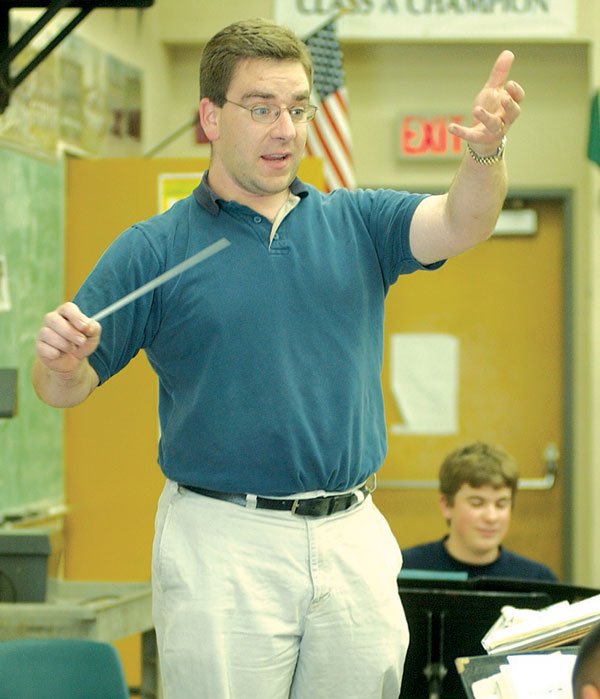In a single office connecting the choir and band rooms sit two
teachers who are the backbone supporting Gilroy High School’s
strong music programs.
In a single office connecting the choir and band rooms sit two teachers who are the backbone supporting Gilroy High School’s strong music programs.
Phil Robb, with more than two decades experience with the high school’s choral program, and Joey Fortino, a 1992 GHS grad that took over the band program seven years ago, are in charge of the success of the school’s five choirs, four bands and color guard.
“I have colleagues that can’t stand their co-workers,” Robb said. “I think it’s fortunate that we work well together. We both feel fortunate to teach and do what we do.”
Fortino and Robb are quick to point to one another when it comes to the success of both programs.
“I think we’re lucky to have Phil,” Fortino said.
“I have really been impressed by Joey’s knowledge as a teacher,” Robb replied. “I think I’ve been able to establish tradition. Once the balloon is inflated, it’s a lot easier. But I’ve learned that it doesn’t take much to deflate a balloon.”
While Robb has built up a reputation with his program, Fortino has had to start almost from scratch to build up the band program.
“When I first started here, we had instruments from the 1950s,” Fortino said. “We had a marimba that was held together by wire and duct tape.”
Thanks to administration, boosters and a “gracious community that is willing to give,” most instruments are more up to date. Fortino said that 70 to 80 percent of that money came from the community.
“People have to believe in it,” Fortino said.
With about 250 students between the programs, Robb and Fortino have represented both the school and the community through concerts both inside and outside of Gilroy.
“We have the opportunity over and over again to represent the school,” Robb said.
Among those opportunities are Robb’s chamber group going abroad to sing in a different country every three years.
“The district has been very gracious,” Robb said.
The students at GHS are getting a lot in return. About 95 percent of those who start in the music program stay in it all four years, and they are getting more out of other areas of their education as well. Fortino’s top band has a 3.6 grade point average, and Robb’s choir group is just as strong.
“The kids I’m taking to Germany (in my chamber choir group), 26 of the 29 are on the honor roll, and that’s not unusual,” Robb said.
This is the chamber’s sixth international trip. The choir has already made five trips to Japan.
The young singers volunteer at the Garlic Festival, fund raisers and Christmas carols to raise money for the trip.
“It basically kills us,” Robb said. “By the 61st time they’re singing ‘We Wish You a Merry Christmas,’ they sing it in a minor key.”
According to Fortino, music is what keeps some of his students interested in school. He said it’s much like his father used to tell him about his own experience in athletics.
“The only thing that kept him in school was football,” Fortino said. “That rolls over to music. It gives some people a way to go through high school.”
Robb said one of the best things about teaching the program is because the students choose to be involved.
“They choose to be a part of it, and I think they know that it’s good for them,” Robb said. “It’s a privilege to be a part of what we’re doing.”
In a country that has dramatically cut art and music programs first when school budgets began to tighten, the Gilroy High teachers know they’re fortunate to still have jobs with the high school and have backing from the administration and district.
“We have administration support and superintendent support,” Robb said.
However, they also know that things could be a lot better.
“We’re in a mediocre situation with excellent programs,” Robb said.
Robb likened the high school’s program to a flower. While it looks pretty at the top, if you cut the roots and stem away, the flower will not survive. And that’s exactly what Robb and Fortino fear about the future of the program. One of the problems that plagues the program is making it more available to students.
“The big thing that’s making it difficult for us is, generally, the upper end student that wants to take advanced classes and band has a difficult time getting into our program,” Fortino said. “There’s a perception that you can’t be in band and get into a really good (college) program.”
At GHS, Fortino and Robb said that many students are steered away from music to engage in other advanced classes or sports.
“That whole intelligence is neglected,” Robb said. “We have story after story of these kids getting into a top college. If we have one kid or more every year that can do it, than it obviously can be done.”
Part of that problem is that students are trying to give themselves the best chance to get into a good school but get competing advise on what looks best on a college application.
“There’s a mindset that is communicated that you need four years of everything to get into the college of your choice,” Robb said. “We undersell how important it is, so many of the gifted kids are giving it up.”
Fortino said one way to help make the program more available is by adding another period.
“If you compare us to San Jose, they have schools that have seven or eight periods, while we have six,” Fortino said. “If they added a period here, it would help a lot, but it would cost many thousands of dollars.”
Right now, athletes often must choose between their sport and music because teams often hold practices during sixth period, when music classes meet.
“I think kids should be able to do both,” Fortino said.
Robb said that he hopes to see that change and sees it happening at one point.
“We’re going in that direction,” he said. “It’s been a sacred cow for many years, but it’s not as sacred as it used to be. … Maybe it’ll be done in my lifetime.”
Robb remembers a time before the district cut music programs from elementary and junior high school classes, and said that has had a huge effect on GHS’s music program.
“In my case, I have no feeder,” Robb said. “We’re paddling upstream without a paddle.”
According to Gretchen Vandenberg, who teaches music at Antonio Del Buono and Rod Kelley and has taught at all of GUSD’s elementary schools over her 30-year career, the music programs in Gilroy took a big hit in the mid ’90s.
“In 1995, they cut the program by two-thirds,” she said. “Last year, all the sixth-graders went to middle school. Then they cut the music program for sixth graders.
“Boys before fourth grade have to know that singing is fun,” she said. “We’re not getting the boys.”
Five years ago, there were 200 kids in the high school choral program, now there are 160. In the band, the number has dropped from 120 to 90.
“I don’t know if that’s the reason, but it makes you think about it,” Fortino said.
“They forget that you start in grade one, not grade nine,” Robb said about the cutting of music programs. “The state standard starts in kindergarten, but in this district, it starts in fourth grade.”
Robb said that not having music programs for elementary school kids makes a huge difference.
“In first grade, kids are not conscious of who’s cool and not cool, they just like to sing,” Robb said. “By fourth grade, there’s enough sophistication that it becomes harder. The older that you get, there’s less toleration about sounding good, especially in a country that is based on instant gratification.
“Because we’re starting kids in fourth grade, we’ve already lost many of them,” he said. “The most important part we took out; the most difficult part we took half away.”
Vandenberg, who puts together a choir concert every year at the end of March – this year’s concert is March 31 – said that cutting the programs will hurt students.
“Music makes them smart,” she said. “It improves their memory. It makes the most difference before third grade.”
In local middle schools, Brownell is the only school that still has a choir.
“Every middle school kid needs to have access, and they don’t have it,” Robb said.
Other places in California have programs that can be looked toward, but Robb and Fortino said much of their success has to do with the community taking control and demanding their children have access to music.
“Visalia is one example of a small district where the parents have bought into teaching the kids all the way through,” Robb said.
Closer to home, Bay Area high schools like Mt. Whitney, Golden West and Redwood which all have bands with 300 or more students, Fortino said.
“Today, kids are going to get music through the radio or on music television,” Robb said. “Most of the music opportunities we used to have aren’t there anymore.”
But, while the teachers know that things could be better in a perfect situation, they now it could be a lot worse.
“We’ve been really lucky,” Fortino said. “I have friends in San Jose who teach band and choir and orchestra at the same time. If you try to do band and choir, one is going to suffer. If I had to do the choir, it would be very weak.”
Robb agreed.
“A majority of the pressure that we have we put upon ourselves. It’s done on our own,” he said. “We could coast along with mediocre programs, but that’s not what we want to do.”















